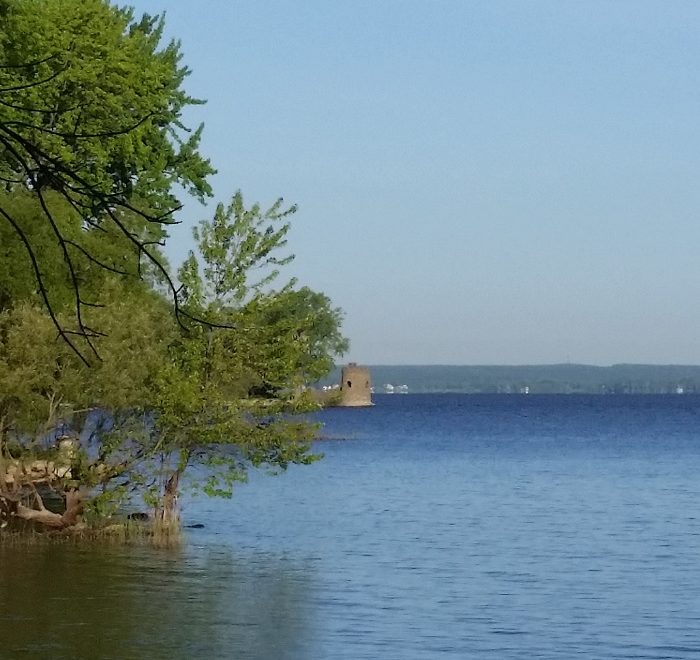This photo shows some of the remaining portions of the castle-like Fort Senneville, which was completed in 1703 on the site of an older fort from 1692. Because the ruins of the Fort are on private property, set far back from the road on a point jutting out into the lake, they can usually only be seen from the water.
When I saw this view of the Fort’s remaining tower this morning, I had to stop my bicycle to snap a one-handed photo with my phone. Isn’t it gorgeous? Many of the shrubs and trees that used to hide the Fort from view have died off this season, due to heavy spring flooding, so this might be my only opportunity to get good views of the ruins.
Fort Senneville was built on a point of land, near the northwestern end of Montreal Island, jutting into the Lake of Two Mountains. This point faces the entrance to the Ottawa River, leading towards our national capital. It was built as a fortified trading post, during the era of Canada’s fur trade, along important canoe routes; between Montreal and Ottawa to the northwest, and towards the Great Lakes to the southwest.
It holds the odd distinction of having been the only privately-held fort in New France, as the area was called prior to creation of Canada.(1) The Fort was mostly destroyed in 1776, by troops under Benedict Arnold during an American incursion into Canada.(1)
As to why I had to snap a one-handed photo, it’s because of a rare neuro-inflammatory disease called Complex Regional Pain Syndrome (CRPS). You might also see it referred to by its former name; Reflex Sympathetic Dystrophy (RSD). Either way, it’s a nasty and extremely painful condition that usually affects the limbs; a hand or foot, or both. In my case, it affects my right hand and lower arm. And, of course, I’m right-handed ‘-)
Because I can’t really use my right hand, I’ve adapted to riding my bike with only my left hand on the handlebars. I hold my right arm straight down my side, and then bend my elbow to hold my lower arm across my body. When I’m riding, my right hand is just over my left hip.
It looks fairly strange, but it works for me! It’s important for me to be able to continue doing the outdoor sports I love, and this is just one example of how a person can adapt to their chronic pain condition.
Whatever condition you or your loved one has, it’s important to find ways to keep doing things you love. There are so many links between chronic pain and depression that it’s important to do anything we can to stave off the negative feelings that can so often set in when a person suffers from unrelenting and constant chronic pain.
In my case, being active and out in nature helps me to feel more like myself than just about anything else does. I’ve always adored outdoor sports, so this makes sense for me. Try to find something that you love to do, or a place you love to be, and find out if there are any ways to get back to that activity – or place – despite your medical condition. Trust me, it helps!
Reference:
(1) Government of Canada. Canadian Register of Historic Places. Managed by Parks Canada, for the Historic Sites and Monuments Board of Canada. Online. Accessed 15 Jun 2017. Web:
https://www.historicplaces.ca/fr/rep-reg/place-lieu.aspx?id=13246&pid=0

